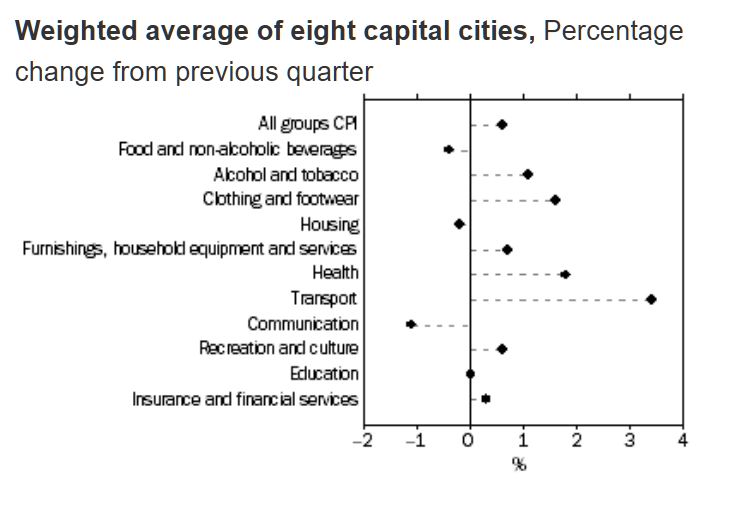The Consumer Price Index (CPI) rose 0.6 per cent in the June quarter 2019, according to the latest Australian Bureau of Statistics (ABS) figures. This follows no movement (0.0 per cent) in the March quarter 2019.
- All groups CPI seasonally adjusted rose 0.7%.
- The trimmed mean rose 0.4%, following a rise of 0.3% in the March quarter 2019.
- Over the twelve months to the June quarter 2019, the trimmed mean rose 1.6%, following a rise of 1.6% over the twelve months to the March quarter 2019.
- The weighted median rose 0.4%, following a rise of 0.1% in the March quarter 2019.
- Over the twelve months, the weighted median rose 1.2%, following a revised rise of 1.4% over the twelve months to the March quarter 2019.
The most significant price rises in the June quarter 2019 were automotive fuel (+10.2 per cent), medical and hospital services (+2.6 per cent), international holiday travel and accommodation (+2.7 per cent) and tobacco (+2.4 per cent).

Prices for fruit and vegetables (-2.8 per cent), domestic holiday travel and accommodation (-1.5 per cent) and electricity (-1.7 per cent) fell this quarter.
ABS Chief Economist, Bruce Hockman said: “Automotive fuel prices rose 10.2 per cent in the June quarter 2019. This rise had a significant impact on the CPI, contributing half of the 0.6 per cent rise this quarter. Automotive fuel prices returned to levels recorded in late 2018 after falling 8.7 per cent in the March quarter 2019.”

Inflation varied across the major centres. In Sydney we saw a large rise in fuel costs, putting the result in the range being experienced by Perth and Darwin.

Main Positive Contributors
- Transport (+3.4%) driven by higher world oil prices and retail fuel margins resulting in an increase in automotive fuel (+10.2%). Automotive fuel rose in all capital cities this quarter, ranging from Canberra (+1.7%) to Sydney (+11.8%).
- Health (+1.8%) due to the cyclical increase in Private Health Insurance premiums in the medical and hospital services (+2.6%) from 1 April. Medical and hospital services rose in all capital cities, ranging from Canberra (+1.8%) to Adelaide (+3.8%).
Main Negative Contributors
- Food and non-alcoholic beverages (-0.4%) driven by an improved supply of fruit and vegetables with autumn/winter produce coming into season, and bananas returning to normal prices following adverse weather conditions in Queensland last quarter. Perth exhibited a smaller fall than the other cities due to localised drought conditions affecting fruit and vegetable supply.
- Housing (-0.2%) driven by utilities (-1.0%), new dwelling purchase for owner-occupiers (-0.2%), and continued weakness in rents (0.0%). Utilities fell in all cities excluding Perth (0.0%) and Darwin (+0.1%), ranging from Hobart (-0.1%) to Brisbane (-3.2%).
The CPI rose 1.6 per cent through the year to the June quarter 2019, after increasing 1.3 per cent through the year to the March quarter. Mr Hockman said: “Annual growth in the CPI continues to be subdued due to falls in a number of administered prices. Through the year, utility prices have fallen 0.2 per cent and child care has fallen 7.9 per cent following the introduction of the Child Care Subsidy package in July 2018.”
